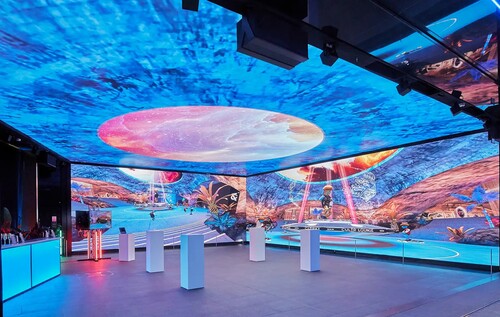
The advantages, costs, and installation techniques of immersive LED display
Understanding Immersive Display Solutions
What Are Immersive Display Solutions?
Immersive display solutions are new tools. They create engaging and dynamic visual environments. These systems use clear screens, projection mapping, virtual reality (VR), and augmented reality (AR). They help users feel part of the content. This could be a virtual world, a sharp video, or an active simulation.
The Technology Behind Immersive Displays
Immersive displays rely on clear LED screens and fine-pitch LED panels. They also use virtual production setups. For example, HD LED screens give bright and lively colors. They make visuals look great. W3 features HD LED screen technology that allows for modular replacement of pixel pitch from P1.56 to P3.91, providing flexibility and customization for various display needs. This lets users upgrade visuals easily. It keeps views clear and vivid.
These displays also have high contrast ratios and quick refresh rates.MuenLED virtual production studio LED screens boast a 6000:1 contrast ratio and a minimum refresh rate of 7680Hz, ensuring no flicker during filming. This makes them perfect for professional places like movie studios or TV broadcasts.

Common Applications of Immersive Display Systems
Immersive display systems are used in many fields:
- Corporate Environments: Clear displays help in boardrooms. They show sharp visuals for presentations. The W3 is specifically crafted for flawless presentations in boardrooms.
- Retail Advertising: Bright HD LED screens boost brand visibility. They grab attention in shops with bold ads.
- Entertainment: Indoor concerts and events use these tools. They create stunning visuals.
- Virtual Production: In film and TV, immersive displays replace green screens. They use realistic backdrops. The use of HD LED video walls in virtual studios significantly reduces shooting time and costs by creating immersive video environments.
Key Benefits of Immersive Display Solutions
Enhancing User Experience Through Immersion
Immersive display solutions make content more fun. They feel real and lively. New LED tech ensures visuals are bright and clear. For example, the W3 gives great audio-visual quality with its clear LED screen. These systems draw people in. They work well in entertainment or learning settings.
Improving Engagement in Various Settings
These displays share lively content. They boost engagement in many places:
- Education: Active displays help students learn tough ideas through simulations.
- Marketing: Shops use big screens to draw customers with bold ads.
- Events: Concerts and shows use fine-pitch LED screens. They create smooth video walls that excite audiences.

Boosting Productivity and Collaboration with Advanced Displays
In offices, immersive displays help teams work better. They show data clearly during meetings or planning. High-resolution screens cut the confusion. They present details well. The W3 is a great tool for better meetings with its sharp visuals. Also, fields like building design or engineering use these for 3D models and reviews.
Factors Affecting the Costs of Immersive Display Solutions
Initial Investment and Equipment Costs
The starting cost of immersive displays depends on many things. These include screen size, image quality, and extra features like modularity or curved shapes. HD LED screens come in many sizes. They fit needs like shop ads or wedding venues. Customization options may raise costs. But they ensure the system fits user needs perfectly.
Maintenance and Operational Expenses
Keeping these systems running needs regular care. This ensures they work well. For example:
- Fixing broken parts like pixel modules can add costs.
- Checking colors and brightness needs expert skills.
Products like the W3 allow cheap upgrades. They use modular replacements instead of full system changes.
Budget Considerations for Different Use Cases
Different fields have different budgets for these systems:
- Corporate Settings: High-end systems like HD LED video walls are key for presentations.
- Retail Spaces: Mid-range options with lively visuals at good prices may work.
- Film Production Studios: Advanced setups with quick refresh rates are needed for pro results.
Installation Tips for Immersive Display Systems
Preparing the Space for Installation
Assessing Room Dimensions and Lighting Conditions
Before setting up an immersive display, check the room’s size and light. Big spaces may need sharper screens or projection systems. This ensures visuals are clear from all angles. Also, room light can affect screens. So, pick displays with high brightness for the best results. MuenLED offers high-brightness LED solutions suited for various lighting conditions.
Ensuring Proper Ventilation and Power Supply
Good airflow is vital to stop equipment from getting too hot. Immersive display systems have many parts that make heat. Proper ventilation helps them last longer. Also, a steady power supply is key. It avoids breaks during use.
Step-by-Step Guide to Setting Up an Immersive Display
Aligning Components for Optimal Viewing Angles
Line up parts carefully for smooth visuals. This means adjusting screens or projectors to remove gaps or distortions. For example, fine-pitch LED screens like those in the MuenLED ViuTV series offer high flatness that enables seamless splicing into big LED video walls.
Testing System Compatibility Before Launch
Test all parts to ensure they work together. Check signal flow between devices. Also, verify software settings. This avoids problems during use.